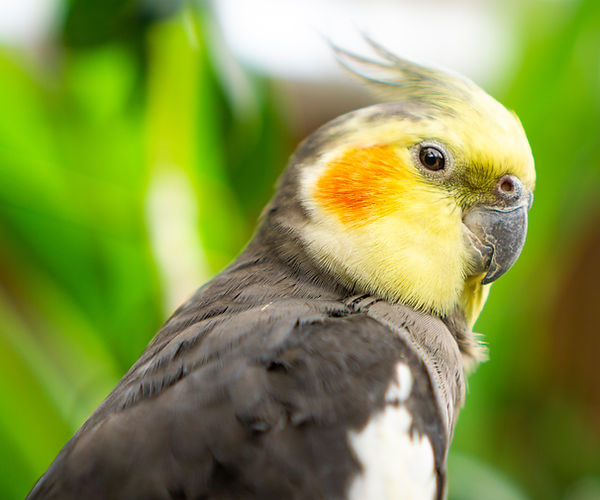
Has your pet bird not been strutting their feathers like they normally do? While dull plumage can indicate several ailments, one notable concern is avian candidiasis. Candida infections are most commonly caused by the opportunistic yeast Candida albicans, which most frequently impacts the gastrointestinal tract [1]. Because birds on broad-spectrum antibiotics are most at risk for candidiasis, it is important to get your pet seen at a vet immediately to avoid further complications [1].
Avian candidiasis is uncomfortable for your feathery friend, with treatment benefiting from early intervention. If you suspect your bird has candidiasis, bring your pet to your exotic veterinarian as soon as possible.
What is Avian Candidiasis?
While the incidence rate of avian candidiasis in pet birds is debated, one study found that approximately 9.2% of sampled birds tested positive for Candida albicans in their cloaca [2]. Candidiasis is predominantly caused by the Candida albicans, which is an opportunistic pathogenic yeast [3]. Additionally, other species such as C. tropicalis, C. parapsilosis, C. glabrata, and Hansenula spp. can cause avian candidiasis [1]. These opportunistic yeasts most commonly impact immunocompromised birds; moreover, candidiasis is most common in cockatiels. Because these yeasts are capable of persisting in your pet’s environment even after your bird is treated, providing proper standards of avian husbandry in low-stress environments is key in preventing infection.
Clinical presentation of avian candidiasis is influenced by bird species, stress, comorbidities, and locality of the infection [1]. While candidiasis most often impacts the gastrointestinal tract, in advanced stages the pathogenic yeast can invade other parts of the bird’s body, although this is less common. Symptoms include but are not limited to:
· Anorexia
· Crop stasis
· White plaques in the oral cavity
· Regurgitation
· Weight loss
· Dull plumage

The fungi Candida albicans, which causes candidiasis
Avian Candidiasis Treatment
Considering poor animal husbandry is one of the main causes of candidiasis infections in birds, your exotic pet veterinarian will help you identify ways to improve your feathery friend’s environment and eliminate the environmental source of the fungal infection. Your exotic pet veterinarian will test your feathery friend to determine the bacteria and/or fungus causing your bird’s infection, and will create a treatment plan based on these findings.
Ultimately, prevention is best. Your exotic bird veterinarian can help you identify possible lifestyle changes you and your bird can make to improve their quality of life and lessen the risk of recurrent candidiasis infection. This entails understanding the exact pathogen that is impacting your bird, with modern technological advances allowing for more targeted clinical diagnostic interventions.
Diagnosing Avian Candidiasis
Diagnosis of avian candidiasis is particularly complex, largely because it is normally secondary to other infections. Additionally, Candida albicans “displays high degree of genetic diversity across isolates, notably variations in the distribution of heterozygous polymorphisms along the genome” [4]. In other words, this makes it difficult to use normal genotyping methods to identify the pathogenic strain. This is particularly important, as current molecular typing has uncovered 19 clades of C. albicans strains [4]. This is clinically relevant, considering approximately 7% of all Candida spp. samples tested at the CDC are resistant the fluconazole, which is commonly used to treat antifungal infections such as candidiasis [5]. Consequently, accurate diagnostics are essential to identify the best mode of treatment for your bird.
Fortunately, Next-Gen sequencing (NGS) has increasingly helped researchers and veterinarians characterize avian microbiota. A study aimed at assessing the avian gut microbiome and the impact of yeast based prebiotic type compounds as potential feed additives using NGS techniques has reaffirmed the importance of NGS approaches in avian diagnostics [6]. This research indicates the clinical applicability of using genomic sequencing to identify and analyze the avian gut microbiome more effectively. The fast turnaround time when compared to culture-based diagnostics makes NGS particularly promising for potential intervention for sick birds.
Despite its name, the MiDOG All-in-One Microbial Test may provide the answer to the diagnostic conundrum that avian candidiasis poses on your feathery friend. Utilizing NGS technology to detect and quantify all microbial DNA through untargeted and comprehensive sequencing and quantitative comparisons to reference databases, the MiDOG NGS technology provides a useful opportunity to shed light on the microbial makeup of your bird’s infection for clinical application. The MiDOG microbiome test is a microbial identification test grounded on scientific research that provides veterinarians DNA evidence for the guided treatment of bird infections, such as candidiasis.
Learn more tips in this extensive guide to bird care.
Find out if your vet uses MiDOG before you book your next appointment!
For health-related questions about your bird or other exotic pet, reach out to a veterinarian that specializes in exotic pets.
References:
- Hoppes, S. M. (2022, October). Mycotic diseases of pet birds – exotic and laboratory animals. Merck Veterinary Manual. Retrieved from https://www.merckvetmanual.com/exotic-and-laboratory-animals/pet-birds/mycotic-diseases-of-pet-birds
- Cafarchia, C., Camarda, A., Romito, D., Campolo, M., Quaglia, N. C., Tullio, D., & Otranto, D. (2006). Occurrence of yeasts in cloacae of migratory birds. Mycopathologia, 161(4), 229–234. https://doi.org/10.1007/s11046-005-0194-z
- Sidrim, J. J., Maia, D. C., Brilhante, R. S., Soares, G. D., Cordeiro, R. A., Monteiro, A. J., & Rocha, M. F. (2010). Candida species isolated from the gastrointestinal tract of cockatiels (Nymphicus hollandicus): In vitro antifungal susceptibility profile and phospholipase activity. Veterinary microbiology, 145(3-4), 324–328. https://doi.org/10.1016/j.vetmic.2010.04.006
- Domán, M., Makrai, L., Lengyel, G., Kovács, R., Majoros, L., & Bányai, K. (2021). Molecular Diversity and Genetic Relatedness of Candida albicans Isolates from Birds in Hungary. Mycopathologia, 186(2), 237–244. https://doi.org/10.1007/s11046-021-00527-3
- Centers for Disease Control and Prevention. (2020, May 18). Antifungal resistance in candida. Centers for Disease Control and Prevention. Retrieved from https://www.cdc.gov/fungal/diseases/candidiasis/antifungal-resistant.html#:~:text=About%207%25%20of%20all%20Candida,Candida%20glabrata%2C%20and%20Candida%20parapsilosis.
- Roto, S. M., Rubinelli, P. M., & Ricke, S. C. (2015). An introduction to the avian gut microbiota and the effects of yeast-based prebiotic-type compounds as potential feed additives. Frontiers in Veterinary Science, 2. https://doi.org/10.3389/fvets.2015.00028
Categories: Birds/Parrots, Exotic Pets, Next-Gen DNA Sequencing Technology, Pet Health, Safety and Wellness

